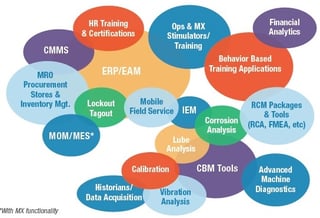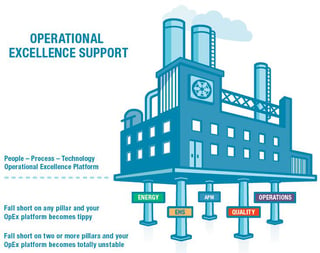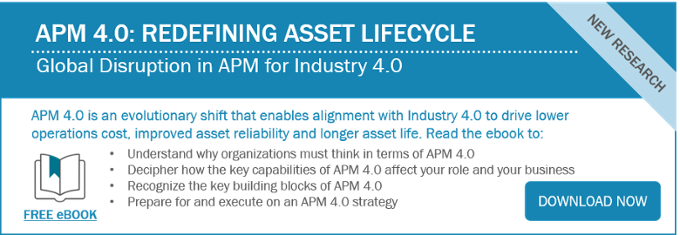 The emergence of the Industrial Internet of Things (IIoT) and Big Data and the associated predictive analytics in the manufacturing and asset intensive industrial sectors has driven widespread use of the term “Asset Performance Management” or APM.
The emergence of the Industrial Internet of Things (IIoT) and Big Data and the associated predictive analytics in the manufacturing and asset intensive industrial sectors has driven widespread use of the term “Asset Performance Management” or APM.
Once a very specific term applied to a narrow set of products that provided specific functionality related to condition-based maintenance (CBM), reliability-centered maintenance (RCM) and asset deployment strategy formulation, APM has now, like many other software categories before it, become a much broader set of functionality.
Depending on the actual solution or service provider using the term APM, the definition can be as specific as the original usage, but with a more enterprise-like deployment scope to all-encompassing relating to anything having to do with the care of “assets.” At LNS Research we have adopted a broader, as opposed to narrower, definition of APM. To understand APM you need to look at all three elements of APM.
This expression has driven the focus and direction of our APM research at LNS since we started coverage of APM in the spring of 2014. The key word in this expression is, of course, “assets.” To understand APM in the context of manufacturing and allied industries is to understand just what assets we are referring to. Every business of course, has multiple types of assets; Financial, Physical, Intangible (such as brand reputation), Intellectual (such as process or product design knowledge) and Human, among others.
However, in the context of APM as it relates to industry the best definition is “the physical equipment, tooling, and facilities that a company uses to produce and deliver its goods and/or services that are the fundamental part of its business.” This is not to say that all the other assets that a business has are not important, but in the context of APM as it relates to manufacturing and similar industries, these are the assets we are referring to.
Performance Is, As Performance Does
Depending on your dictionary of choice the exact meaning of “performance” can vary slightly, but the common denominator is that performance is “the process of carrying out or accomplishing an action, task, or function.” So in the context of APM performance means that an asset is accomplishing its intended function. The details of this definition are important because the key is to note it refers to the intended function. This performance means that an asset is delivering the value for which it was acquired and doing so at a level that is “as intended.”
Management Is a Process
While both asset and performance have relatively straightforward definitions, the “management” component of APM is more subject to interpretation and is what has led to the wide variation in scope when vari ous groups try and define APM. For traditionalists that narrowly define APM they tend to focus on the “skill of controlling and making decisions” about an asset’s performance while those, including myself, take a broader definition of “the act of controlling the business of” the asset performance.
ous groups try and define APM. For traditionalists that narrowly define APM they tend to focus on the “skill of controlling and making decisions” about an asset’s performance while those, including myself, take a broader definition of “the act of controlling the business of” the asset performance.
While these distinctions are subtle it helps to explain the evolution of APM from a point solution to an approach to Operational Excellence that embraces solutions from raw data collection on asset condition to Enterprise Asset Management (EAM) applications that are focused on record keeping and planning and scheduling maintenance activities. So—APM is a business process area supporting Operational Excellence.
MESA’s Definition Is Among the More Comprehensive
MESA International, which LNS Research has had a substantial relationship with since our founding over four years ago, notably with our joint “Metrics That Matter” research initiative, which we’ll once again be commencing shortly after the new year, has a definition that closely aligns with the LNS Research definition of APM:
“Asset Performance Management (APM) is an approach to managing the optimal deployment of assets to maximize profitability and predictability in product supply, focusing on real margin contribution by asset by product code. Rather than looking at an asset on the basis of market value or depreciated value, companies can see how the asset is contributing to their profitability by looking at how individual assets are performing—whether inventory or Plant, Property, and Equipment (PP&E)—and developing a vision of how they want to allocate resources to assets in the future. APM is not necessarily purely financial or even operational, but it will cross functional lines. It combines best-of-breed enterprise asset management (EAM) software with real-time information from production and the power of cross-functional data analysis & advanced analytics. More broadly, it looks at the whole lifecycle of an asset, enabling organizations to make decisions that optimize not just their assets, but their operational and financial results as well.”
LNS Research Defines APM as Broad in Scope & Multi-Dimensional
Like most software, APM has evolved from a singularly focused application or limited collection of functions into a business process activity that embraces all of the tools and technologies that are required to keep physical (and operational software) assets performing their intended function. It includes all elements from the actual data collection to the diagnostic tools such as vibration monitoring and analysis to spare parts management to the asset registry and asset related work scheduling and expense tracking.